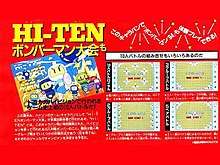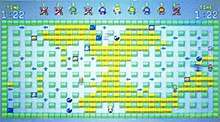Hi-Ten Bomberman
Hi-Ten Bomberman[lower-alpha 1] is an action-maze video game developed and first showcased by Hudson Soft at their Super Caravan events in 1993 in Japan.[1][2][3] It is a multiplayer-only entry in the Bomberman franchise, featuring support for up to ten players and widely regarded by many to be the first commercially created game for widescreen HDTVs, as well as being regarded to be the basis for Saturn Bomberman, but it was never released for the general public.[4][5][6][7][8][9]
| Hi-Ten Bomberman | |
|---|---|
 | |
| Developer(s) | Hudson Soft |
| Publisher(s) | Hudson Soft |
| Designer(s) | Katsuhiro Nozawa |
| Series | Bomberman |
| Release |
|
| Genre(s) | Action, maze |
| Mode(s) | Single-player, multiplayer |
Gameplay

Hi-Ten Bomberman is a multiplayer-only action-maze game that plays very similarly like other games in the Bomberman franchise, featuring support for up to ten players, with each one being assigned to a different colored Bomberman character depending on which controller port is used with the multitaps while utilizing a large, landscape-style HDTV widescreen to display its vast playfield.[1][3][10] The main objective of the game is to defeat all of the opponents filling the playfield by placing bombs, while destroying the blocks in the mazes may uncover useful items for the players including extra bombs, fire range increasers and other items.[10]
Modes
There are five different modes of play to choose from at the main title screen: Battle Royale, 2 Group Battle, 3 Group Battle, 5 Group Battle and 1 VS 9 Battle. Battle Royal, as the name implies, is a deathmatch mode between ten players where the last standing Bomberman becomes the winner. 2 Group Battle is a multiplayer mode where two teams consisting of five players battle against each other. 3 Group Battle is a nine-player-only battle mode in which three teams of three players are pitted against each other. 5 Group Battle is a cooperative multiplayer mode where five two-player teams battle to become the winner. 1 VS 9 Battle is a ten-player mode where one player is pitted against a large nine-player team.
History
Development
Hi-Ten Bomberman was conceived by Katsuhiro Nozawa, who previously worked on several Hudson Soft titles such as Star Soldier and J.J. & Jeff.[4][5][11] The game ran on a combination of two PC Engine units for basic hardware and controller inputs along with a custom PC-based PCB nicknamed Iron Man,[lower-alpha 2] which later became the basis for the PC-FX but no plans for a home release on the platform was considered.[1][3][4][5][7] Between five and ten units were produced and each one cost around JP¥2,000,000.[3][11][12][13] In an interview with Gamasutra, former Hudson Soft executive Takahashi Meijin stated that the reason for the company in developing the project was due to NHK wanting to push the HDTV market in Japan at the time and due to the expanded 16:9 aspect ratio, it allowed the team to have ten players on-screen but required writing a custom technology to do so.[3][7]
Release
Hi-Ten Bomberman was first showcased to attendees at the 1993 Super Caravan event hosted by Hudson Soft and was last seen playable at Studio Park on the NHK Broadcasting Center in August 1997 in Japan, where it was available to play for the general public.[3][6][8][10] It is widely credited by video game magazines and other dedicated outlets to be the first commercial game created for widescreen HDTVs, though Namco's 1988 Homerun Contest preceded it five years prior.[14][15][16] Despite being showcased only in Japan, Hudson Soft had plans to showcase the game across other regions, which never came to fruition for unknown reasons.[4][5]
In 1994,[17] an updated version of Hi-Ten Bomberman titled Hi-Ten Chara Bomb[lower-alpha 3] was first showcased by Hudson Soft to the attendees at the 1994 Super Caravan event, which increased the arena's size and introduced selectable characters, most of which were from other Hudson properties such as Bonk, Far East of Eden, Milon's Secret Castle and Momotaro Densetsu.[4][5][18]
Reception and legacy
Both Edge and Next Generation praised Hi-Ten Bomberman for the gameplay and technological achievement.[4][5] The game has been regarded to be the basis for Saturn Bomberman.[8] In 2019, multiple discs containing data of the game were found by Takahashi Meijin.[6][13]
Notes
References
- Yamanaka, Naoki (September 1993). "Basic Magazine News: テレビゲームにもハイビジョンの時代がやってくる!". Micom BASIC Magazine (in Japanese). No. 135. The Dempa Shimbunsha Corporation. p. 181.
- "The Advent of HD Gaming...in 1993?!". Hudson Entertainment. Facebook. 6 August 2010. Archived from the original on 3 January 2014. Retrieved 15 June 2019.
- Szczepaniak, John (4 November 2015). Hudson Soft Chapter - Takashi TAKEBE. The Untold History of Japanese Game Developers. 2. S.M.G. Szczepaniak. pp. 71–83. ISBN 978-1518818745.
- "Prescreen - Hudson Soft". Edge. No. 17. Future plc. February 1995. pp. 46–49.
- "Alphas - Hudson Soft". Next Generation. No. 3. Imagine Media. March 1995. pp. 78–81.
- Wong, Alistair (March 15, 2019). "Long-lost Early HD Game Hi-Ten Bomberman Preserved Thanks To Hudson's Takahashi Meijin". Siliconera. Curse LLC. Retrieved 2019-09-08.
- Sheffield, Brandon (October 2, 2008). "The Game Master Speaks: Hudson's 'Takahashi-Meijin' Goes Retro (Page 3)". Gamasutra. UBM Technology Group. Retrieved 2019-06-15.
- Hunt, Stuart (August 2009). "The Complete History Of Bomberman". Retro Gamer. No. 67. Imagine Publishing. pp. 27–34.
- Plunkett, Luke (May 12, 2011). "The HD Console Game From...1993?". Kotaku. G/O Media. Retrieved 2019-09-30.
- ハイテンボンパーマン. Bomberman Maniax (ボンバーマンマニアックス) (in Japanese). Aspect. May 1995. ISBN 4-89366-369-0.
- Meijin, Takahashi (March 12, 2019). "「Hi-Tenボンバーマン」のDisk". 16連射のつぶやき (in Japanese). Ameba. Retrieved 2019-03-21.
- Meijin, Takahashi (3 November 2005). "HiTENキャラボンの思い出". 高橋名人BLOG『16連射のつぶやき』 (in Japanese). Hudson Soft. Archived from the original on 26 February 2006. Retrieved 15 June 2019.
- Meijin, Takahashi. "HI-TENボンバーマン". 16shot.jp (in Japanese). Fields Corporation. Retrieved 15 June 2019.
- "ハイビジョン用TVゲームを ナムコが開発 9月から各地で一般公開へ". Game Machine (in Japanese). No. 342. Amusement Press, Inc. 15 October 1988. p. 5.
- "26th Amusement Machine Show - ホームランコンテスト (ナムコ)". Game Machine (in Japanese). No. 343. Amusement Press, Inc. 1 November 1988. p. 9.
- "Overseas Readers Column - New Videos Unveiled For Overseas Market". Game Machine (in Japanese). No. 343. Amusement Press, Inc. 1 November 1988. p. 26.
- Prezeau, Olivier (October 1994). "Consoles: Jouer À Dix À Bomberman?". Joystick (in French). No. 53. Hachette Digital Presse. p. 134.
- "News: This Month on Edge - A gloriously haphazard collection of rumours, short stories and stop-press gameshots". Edge. No. 13. Future plc. October 1994. pp. 18–19.